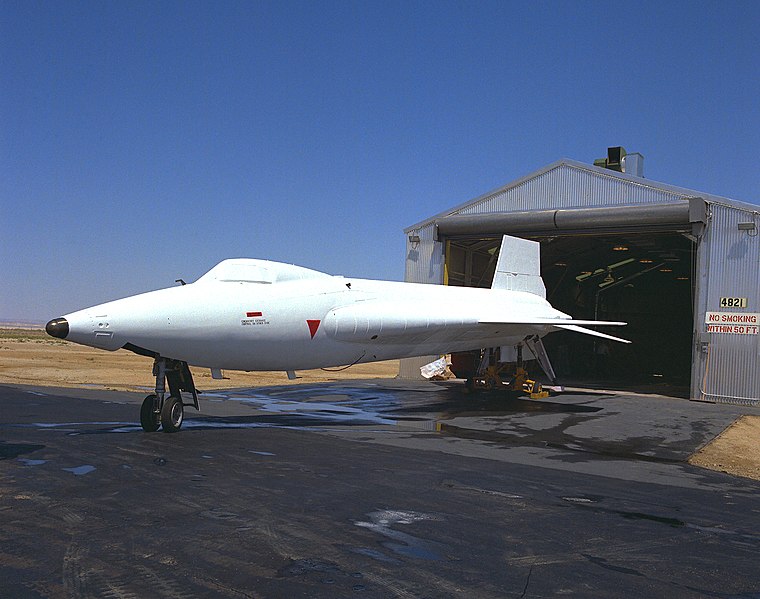File:X-15A2 1.jpg

Original file (3,030 × 2,390 pixels, file size: 5.15 MB, MIME type: image/jpeg)
Captions
Captions
Summary
[edit]| DescriptionX-15A2 1.jpg |
English: After receiving a full-scale ablative coating to protect the craft from the high temperatures associated with supersonic flight, the X-15A-2 rocket-powered research aircraft was then covered with a white sealant coat. This ablative coating and sealant would help the #2 aircraft reach the record speed of 4,520 mph (Mach 6.7).
The basic X-15 was a rocket-powered aircraft 50 ft long with a wingspan of 22 ft. However, the X-15A-2 had been elongated to 52 ft 5 in. Like the other two X-15s, it was a missile-shaped vehicle with an unusual wedge-shaped vertical tail, thin stubby wings, and unique side fairings that extended along the side of the fuselage. The X-15 weighed about 14,000 lb empty and approximately 34,000 lb at launch. The XLR-99 rocket engine, manufactured by Thiokol Chemical Corp., was pilot controlled and was capable of developing 57,000 lb of thrust. North American Aviation built three X-15 aircraft for the program. The X-15 research aircraft was developed to provide in-flight information and data on aerodynamics, structures, flight controls, and the physiological aspects of high-speed, high-altitude flight. A follow-on program used the aircraft as a testbed to carry various scientific experiments beyond the Earth's atmosphere on a repeated basis. For flight in the dense air of the usable atmosphere, the X-15 used conventional aerodynamic controls such as rudders on the vertical stabilizers to control yaw and movable horizontal stabilizers to control pitch when moving in synchronization or roll when moved differentially. For flight in the thin air outside of the appreciable Earth's atmosphere, the X-15 used a reaction control system. Hydrogen peroxide thrust rockets located on the nose of the aircraft provided pitch and yaw control. Those on the wings provided roll control. Because of the large fuel consumption, the X-15 was air launched from a B-52 aircraft at 45,000 ft and a speed of about 500 mph. Depending on the mission, the rocket engine provided thrust for the first 80 to 120 sec of flight. The remainder of the normal 10 to 11 min. flight was powerless and ended with a 200-mph glide landing. Generally, one of two types of X-15 flight profiles was used; a high-altitude flight plan that called for the pilot to maintain a steep rate of climb, or a speed profile that called for the pilot to push over and maintain a level altitude. The X-15 was flown over a period of nearly 10 years -- June 1959 to Oct. 1968 -- and set the world's unofficial speed and altitude records of 4,520 mph (Mach 6.7) and 354,200 ft in a program to investigate all aspects of piloted hypersonic flight. Information gained from the highly successful X-15 program contributed to the development of the Mercury, Gemini, and Apollo piloted spaceflight programs, and also the Space Shuttle program. The X-15s made a total of 199 flights, and were manufactured by North American Aviation. X-15-1, serial number 56-6670, is now located at the National Air and Space Museum, Washington DC. North American X-15A-2, serial number 56-6671, is at the United States Air Force Museum, Wright-Patterson AFB, Ohio. X-15-3, serial number 56-6672, crashed on 15 November 1967, resulting in the death of Maj. Michael J. Adams. |
| Date | Taken on 26 June 1967 |
| Source | https://www.dfrc.nasa.gov/Gallery/Photo/X-15/HTML/ECN-1770.html |
| Author | NASA |
This image or video was catalogued by Armstrong Flight Research Center of the United States National Aeronautics and Space Administration (NASA) under Photo ID: ECN-1770. This tag does not indicate the copyright status of the attached work. A normal copyright tag is still required. See Commons:Licensing. Other languages:
Afrikaans ∙ العربية ∙ беларуская (тарашкевіца) ∙ български ∙ Bahaso Jambi ∙ català ∙ čeština ∙ dansk ∙ Deutsch ∙ English ∙ español ∙ فارسی ∙ français ∙ galego ∙ magyar ∙ հայերեն ∙ Bahasa Indonesia ∙ italiano ∙ 日本語 ∙ македонски ∙ മലയാളം ∙ Nederlands ∙ polski ∙ português ∙ русский ∙ sicilianu ∙ slovenščina ∙ Türkçe ∙ українська ∙ 简体中文 ∙ 繁體中文 ∙ +/− |
Licensing
[edit]| Public domainPublic domainfalsefalse |
| This file is in the public domain in the United States because it was solely created by NASA. NASA copyright policy states that "NASA material is not protected by copyright unless noted". (See Template:PD-USGov, NASA copyright policy page or JPL Image Use Policy.) |  | |
 |
Warnings:
|
File history
Click on a date/time to view the file as it appeared at that time.
| Date/Time | Thumbnail | Dimensions | User | Comment | |
|---|---|---|---|---|---|
| current | 14:21, 15 December 2020 |  | 3,030 × 2,390 (5.15 MB) | Huntster (talk | contribs) | Cropped 8 % vertically using CropTool with lossless mode. |
| 13:11, 21 April 2006 |  | 3,030 × 2,606 (5.19 MB) | GDK (talk | contribs) | X-15A2 Source: http://www.dfrc.nasa.gov/Gallery/Photo/X-15/Large/index.html {{PD-NASA}} |
You cannot overwrite this file.
File usage on Commons
The following 2 pages use this file:
File usage on other wikis
The following other wikis use this file:
- Usage on de.wikipedia.org
- Usage on en.wikipedia.org
- Usage on meta.wikimedia.org
- Usage on www.wikidata.org
Metadata
This file contains additional information such as Exif metadata which may have been added by the digital camera, scanner, or software program used to create or digitize it. If the file has been modified from its original state, some details such as the timestamp may not fully reflect those of the original file. The timestamp is only as accurate as the clock in the camera, and it may be completely wrong.
| JPEG file comment | File written by Adobe Photoshop¨ 4.0 |
|---|